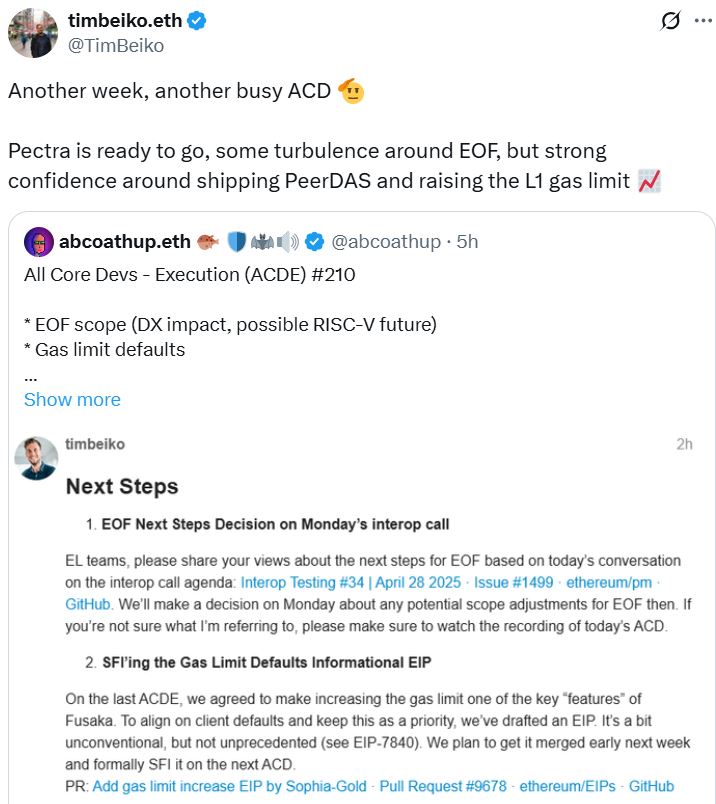Ethereum Gas Limit Increase Proposed for Fusaka Hard Fork: A 4x Jump
Ethereum core developers are contemplating a substantial increase in the layer 1 gas limit, potentially quadrupling it to 150 million, as a key feature of the Fusaka hard fork, the upgrade following Pectra. This ambitious proposal seeks to significantly improve Ethereum’s scalability and efficiency.
The potential increase, outlined in Ethereum Improvement Proposal (EIP) 9678 by Ethereum Foundation developer Sophia Gold, was a major topic during the recent All Core Devs Execution (ACDE) meeting. The proposal aims to make the gas limit increase a central feature of the Fusaka upgrade.
According to Ethereum core developer Tim Beiko, aligning client defaults and prioritizing the gas limit increase necessitates the EIP. Further modifications to the protocol might be required to fully support the higher gas limit, potentially leading to the inclusion of additional EIPs in Fusaka, even though the fork scope has been tentatively finalized.

The next Ethereum upgrade, Pectra, is slated for mainnet deployment in May, with Fusaka tentatively scheduled for late 2025.
Rationale Behind the Gas Limit Increase
The primary motivation behind the proposed gas limit increase is to improve layer 1 execution and scalability without introducing entirely new features. This enhancement is intended to make Ethereum more efficient and capable of handling a greater volume of transactions.
However, the move necessitates close collaboration with execution layer developers, as testing and bug fixing will be crucial at the higher gas limits. Client developers’ time is essential for thorough testing and addressing any issues that arise. By including the gas limit increase as an EIP in a hard fork, the Ethereum community aims to commit to this critical improvement.

Beiko emphasized that while validators ultimately determine the gas limit, an EIP coordinating client defaults is essential to maintain the priority and ensure all clients update their defaults by the time Fusaka is implemented.
What is Gas and Gas Limit in Ethereum?
In Ethereum, “gas” is a unit that measures the computational effort required to execute specific operations on the Ethereum network. Each transaction and smart contract execution requires a certain amount of gas, and users pay for this gas in Ether (ETH), Ethereum’s native cryptocurrency. The “gas limit” refers to the maximum amount of gas a user is willing to spend on a particular transaction. If the gas required for the transaction exceeds the gas limit, the transaction will fail, and the user will still pay for the gas consumed up to that point.
Why Increase the Gas Limit?
Increasing the gas limit allows for more complex operations and larger transactions to be processed within a single block. This can lead to several benefits:
- Higher Transaction Throughput: With a higher gas limit, more transactions can be included in each block, increasing the overall transaction throughput of the Ethereum network.
- Enhanced Scalability: A higher gas limit can improve the scalability of Ethereum by allowing it to handle more complex applications and a greater number of users.
- Reduced Transaction Fees: While not guaranteed, a higher gas limit can potentially lead to lower transaction fees, as increased throughput can alleviate congestion on the network.
Potential Challenges and Considerations
While increasing the gas limit offers several advantages, it also poses potential challenges:
- Increased Block Size: A higher gas limit can lead to larger block sizes, which can increase the storage requirements for Ethereum nodes and potentially make it more difficult for individuals to run a node.
- Security Risks: Larger blocks and more complex operations can introduce new security risks that need to be carefully considered and mitigated.
- Client Implementation: Ensuring that all Ethereum clients can handle the increased gas limit efficiently and securely is crucial for the successful implementation of the upgrade.
The average Ethereum gas limit was approximately 30 million after the August 2021 increase. Validators had previously supported raising the network’s gas limit on Feb. 4, aiming to increase the maximum amount of gas used for transactions in a single block. Current data indicates a gas limit of just under 36 million.
Impact on Ethereum Ecosystem
The proposed gas limit increase has the potential to significantly impact the Ethereum ecosystem. It could lead to:
- Growth of DeFi Applications: Higher throughput can enable the development of more complex and sophisticated decentralized finance (DeFi) applications.
- Increased Adoption of NFTs: A higher gas limit could facilitate the creation and trading of non-fungible tokens (NFTs), making the process more efficient and affordable.
- Expansion of Enterprise Use Cases: Improved scalability can attract more enterprises to adopt Ethereum for various use cases, such as supply chain management and data management.
The Ethereum community will closely monitor the testing and implementation of the gas limit increase, as it represents a crucial step in enhancing the network’s capabilities and ensuring its long-term success.